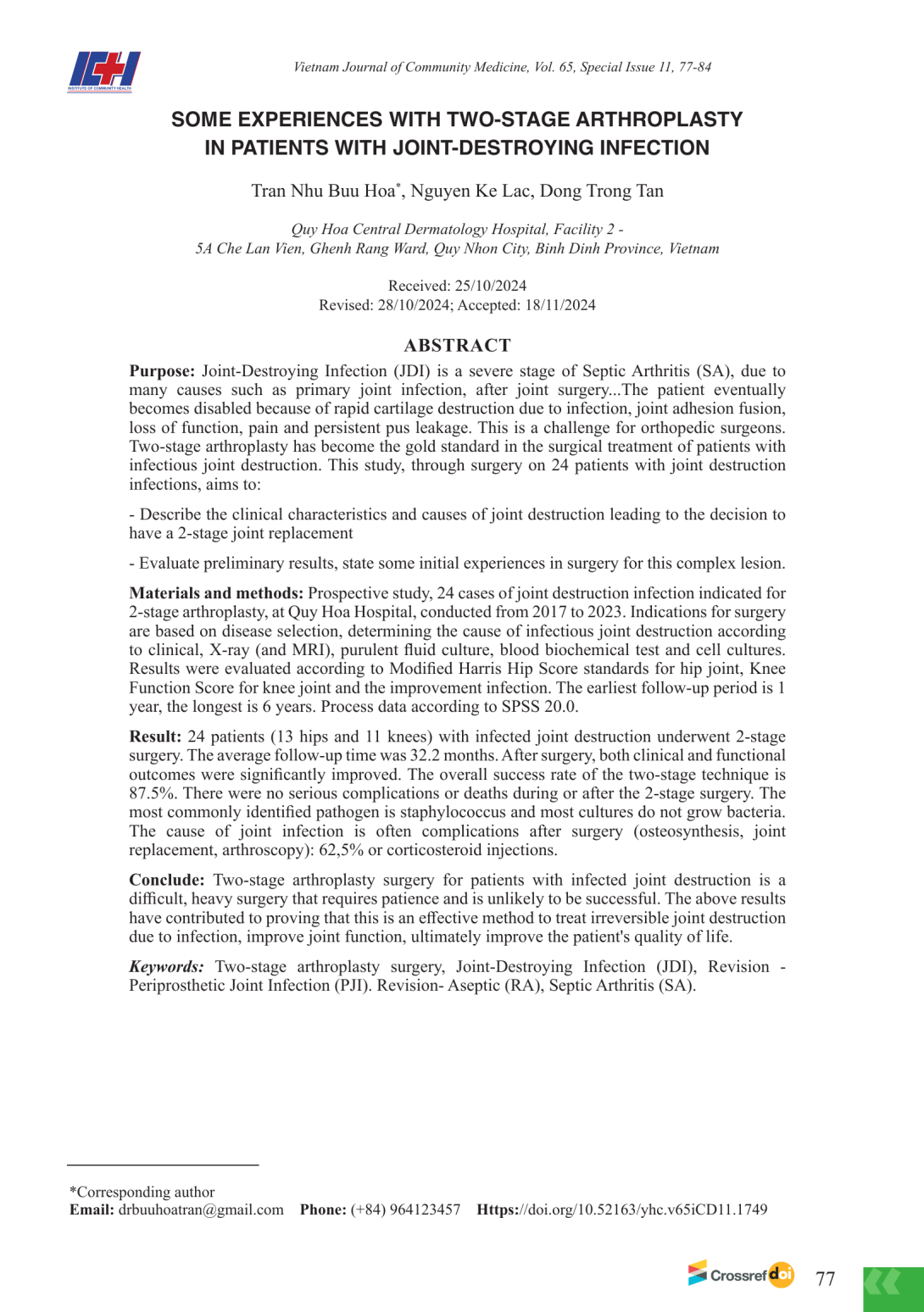
Mục đích nghiên cứu: Nhiễm trùng khớp có hủy hoại khớp (Joint-Destroying Infection- JDI) là giai đoạn nặng của viêm khớp nhiễm trùng (Septic Arthritis - SA). Bệnh nhân cuối cùng tàn phế vì hủy hoại khớp, sụn phá huỷ nhanh do nhiễm trùng, khớp hư, dính mất chức năng, đau đớn, dò mủ dai dẳng. Đây là một thách thức lớn trong điều trị hiện nay. Thay khớp hai giai đoạn đã trở thành tiêu chuẩn vàng cho điều trị bệnh nhân nhiễm trùng có hủy hoại khớp. Nghiên cứu này nhằm mục tiêu: - Mô tả đặc điểm lâm sàng và nguyên nhân gây nhiễm trùng hủy hoại khớp đưa đến quyết định thay khớp 2 giai đoạn - Đánh giá kết quả sơ bộ, nêu vài kinh nghiệm ban đầu cho phẫu thuật tổn thương phức tạp này. Phương pháp: Nghiên cứu tiến cứu: 24 trường hợp nhiễm trùng hủy hoại khớp, được thay khớp 2 giai đoạn, cùng một phẫu thuật viên chính, tại Bệnh viện Trung ương Quy Hòa, thực hiện từ 1/ 2017 đến 11/2023. Chỉ định mổ dựa trên chọn bệnh, xác định nguyên nhân hủy hoại khớp nhiễm trùng theo lâm sàng, X-quang (MRI), cấy mủ, sinh hóa, tế bào. Chỉ mổ bệnh nhân ASA phân loại 1,2,3. Thất bại điều trị được định nghĩa là có sự tái phát nhiễm trùng bất kỳ lúc nào sau lần thay khớp giai đoạn 2. Đánh giá kết quả theo tiêu chuẩn Harris Hip Score cho khớp háng và Knee Function Score cho khớp gối. Thời gian theo dõi sớm nhất 1 năm, dài nhất 6 năm. Xử lý số liệu theo SPSS 20.0. Kết quả: 24 bệnh nhân (13 khớp háng và 11 khớp gối) đã được phẫu thuật 2 giai đoạn. Thời gian theo dõi trung bình là 36,2 tháng. Sau phẫu thuật, cả kết quả lâm sàng và chức năng được cải thiện đáng kể, qua thang điểm Modified Harris Score/ Knee Function Score. Tỷ lệ thành công chung của kỹ thuật hai giai đoạn là 87.5%. Không có biến chứng tử trong và sau mổ 2 giai đoạn. Tác nhân gây bệnh được xác định nhiều nhất là tụ cầu và phần lớn là cấy không mọc vi khuẩn. Nguyên nhân nhiễm trùng khớp phần lớn (62,5%) là do biến chứng sau mổ can thiệp khớp (kết xương vùng khớp, thay khớp, nội soi khớp), do tiêm corticoide vào khớp… Kết luận: Phẫu thuật thay khớp hai giai đoạn cho bệnh nhân có hủy hoại khớp nhiễm trùng là phẫu thuật khó, nặng nề, nguy cơ thất bại cao, nhất là các trường hợp nhiễm trùng sau thay khớp (Periprosthetic Joint Jnfection -PJI). Với kết quả bước đầu chứng tỏ đây là phương pháp hiệu quả điều trị các hủy hoại khớp không hồi phục do nhiễm trùng, cải thiện chức năng khớp, nâng cao chất lượng sống người bệnh.
Joint-Destroying Infection (JDI) is a severe stage of Septic Arthritis (SA), due to many causes such as primary joint infection, after joint surgery...The patient eventually becomes disabled because of rapid cartilage destruction due to infection, joint adhesion fusion, loss of function, pain and persistent pus leakage. This is a challenge for orthopedic surgeons. Two-stage arthroplasty has become the gold standard in the surgical treatment of patients with infectious joint destruction. This study, through surgery on 24 patients with joint destruction infections, aims to:- Describe the clinical characteristics and causes of joint destruction leading to the decision to have a 2-stage joint replacement- Evaluate preliminary results, state some initial experiences in surgery for this complex lesion. Materials and methods: Prospective study, 24 cases of joint destruction infection indicated for 2-stage arthroplasty, at Quy Hoa Hospital, conducted from 2017 to 2023. Indications for surgery are based on disease selection, determining the cause of infectious joint destruction according to clinical, X-ray (and MRI), purulent fluid culture, blood biochemical test and cell cultures. Results were evaluated according to Modified Harris Hip Score standards for hip joint, Knee Function Score for knee joint and the improvement infection. The earliest follow-up period is 1 year, the longest is 6 years. Process data according to SPSS 20.0. Result: 24 patients (13 hips and 11 knees) with infected joint destruction underwent 2-stage surgery. The average follow-up time was 32.2 months. After surgery, both clinical and functional outcomes were significantly improved. The overall success rate of the two-stage technique is 87.5%. There were no serious complications or deaths during or after the 2-stage surgery. The most commonly identified pathogen is staphylococcus and most cultures do not grow bacteria. The cause of joint infection is often complications after surgery (osteosynthesis, joint replacement, arthroscopy): 62,5% or corticosteroid injections. Conclude: Two-stage arthroplasty surgery for patients with infected joint destruction is a difficult, heavy surgery that requires patience and is unlikely to be successful. The above results have contributed to proving that this is an effective method to treat irreversible joint destruction due to infection, improve joint function, ultimately improve the patient's quality of life.
- Đăng nhập để gửi ý kiến
